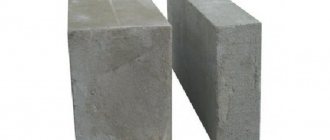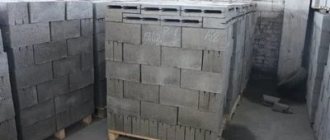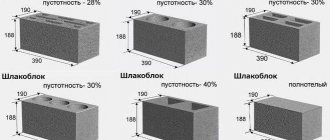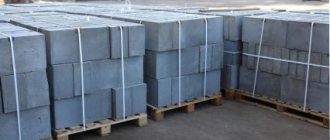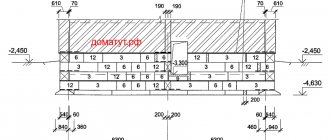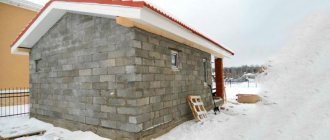Once the construction of the zero cycle is completed and the foundation has gained strength, you can begin building the walls. An important role in preparing for this process is played by the purchase of materials for masonry. In particular, the gas block must be correctly calculated in quantity, delivered to the site, unloaded and stored in such a way as not to damage the rather fragile stone.
The volume purchased depends on how many pieces of aerated concrete are in the pallet. This, in turn, is influenced by the size of the stacked block and, of course, the size of the pallet itself. In the article we will understand the intricacies of such calculations.
Number of gas blocks in one pallet or pack
After the gas blocks have gained strength at the factory, they are put into pallets, wrapped with shrink (stretch) film, and sent to the finished product warehouse, from where they are shipped to customers. Naturally, no one opens the packaging to sell the blocks individually, so the volume of one pallet is the minimum supply norm.
Two types of pallets can be used for storing masonry materials: a standard pallet with dimensions of 1000*1200 mm (aerated concrete loading volume is 1.8-2 m3) and a Euro pallet with dimensions of 800*1200 mm (no more than 1.62 m3 of aerated concrete blocks can be placed).
Knowing the pallet loading rate, it is easy to determine how many blocks fit in it. To do this, the volume of the pallet is divided by the volume of one block. To find out, you just need to multiply the three parameters of the product in meters: length, height and width. Below are some illustrative examples.
200x300x600
- We calculate the volume of the block: 0.2 m*0.3 m*0.6 m = 0.036 m3.
- We divide the volume of a standard pallet by the volume of the block: 1.8 m3: 0.036 m3 = 50 pieces.
- Quantity per Euro pallet: 1.62 m3: 0.036 m3 = 45 pieces.
600x250x300
- Cubic capacity of one block: 0.25 m*0.3 m*0.6 m = 0.045 m3.
- Number of blocks in a standard pallet: 1.8 m3: 0.045 m3 = 40 pieces.
- Number of products in a Euro pallet: 1.62 m3: 0.045 m3 = 36 pieces.
600x400x250
- Volume of one product: 0.6 m* 0.4 m* 0.25 m = 0.06 m3.
- Number of pieces in a standard pallet: 1.8 m3: 0.06 m3 = 30 pieces.
- Number of pieces in a Euro pallet: 1.62 m3: 0.06 m3 = 27 pieces.
Options
To find out the number of cubes of aerated concrete in one pallet, you should know the dimensions of the products. For walls, building elements are used whose thickness exceeds 20 cm. Such sizes of 200 or 250 mm are the most common; they are used for the construction of one-story buildings. The parameters of the products determine how many pieces will fit in 1 cube. During monolithic frame construction work, private builders and professionals use aerated concrete blocks with a thickness of 250 mm. If we compare such a wall with brickwork, in order to achieve similar features with aerated concrete, the brick wall should be 1 meter thick.
How to calculate the required number of gas blocks
You can calculate gas blocks for an object yourself, or use an online calculator. As practice shows, in the first case the result will be more accurate, so we will consider this option.
The principle of calculation is to determine the volume of walls - in the same way as the volume of one block is determined by multiplying spatial parameters. For walls of different thicknesses, calculations must be done separately, because in this case the blocks will be purchased in different sizes. To make the correct calculation, you need to have before your eyes a house plan or plans of all floors separately, if there are several of them. The drawing is needed to see not only the geometric parameters of the walls, but also the number of window and door openings.
Vitaly Kudryashov
Builder Author of the portal full-houses.ru
Ask a Question
If you have a project, you can navigate the dimensions of the openings using the explication of the joinery. During non-design construction, you need to immediately determine where and what windows and doors will be located. That is, you will have to make the drawing yourself, but to understand how it should look and how to work with it, we will give a specific example.
Calculation of the volume of aerated concrete for a house
Before us is a floor plan of a house measuring 12.5 * 9 m. The drawing shows that the thickness of the external walls is 500 mm, internal load-bearing walls 400 mm, internal non-load-bearing walls 250 mm and partitions 120 mm. The height of the walls is not visible on the plan, but let’s take the standard option of 2.7 m.
We calculate the volume of each version of enclosing structures separately, but we will consider only external walls as an example. The rest is calculated by analogy.
- So, the external load-bearing walls have a thickness of 500 mm. According to the plan, their total length is: 12.5+9+6+6+2+3+1+3.5 = 43 m. Multiplying it by the height we get the area of the walls: 43 m * 2.7 m = 116.1 m2.
- Before calculating cubic capacity, you need to subtract the total area of all openings from the area of the walls. In this case, these are: the front door, garage doors, and 6 windows of different sizes. Let’s say the total area of the openings is 21.1 m2. We subtract: 116.1-21.1 = 95 m2, and we get the area of the walls without openings.
- We multiply the area by the thickness and get the cubic capacity of the walls: 95 m2 * 2.7 m = 256.5 m3.
- We add 5% reserve for cutting, we get 270 m3 of gas blocks.
To build walls of this thickness with single-layer masonry, you can use blocks measuring 625 * 250 * 500 mm, the volume of one product is 0.0781 m3. Such blocks fit 1,406 m3 on a pallet. Dividing the total volume of aerated concrete by the capacity of one pallet, we get 192 pallets. It is for this number of packages that you will need to order a machine.
Influencing factors
The weight of gas silicate blocks is a variable quantity, depending not only on the dimensions of the product, as is often (and erroneously) thought. First of all, the density of the solid part of the product is of great importance.
The moisture content of the gas silicate will also have to be taken into account. The density level is indicated in the labeling of the supplied product
It is usually measured in kg per m3.
Density grades are designated as DXXX, where XXX is the desired value. There is nothing complicated here; the specific gravity of mass-produced blocks can be 300 or 400 kg. For denser products this figure reaches 500 or even 600 kg. The effect of humidity is also predictable - the more water a sample absorbs, the heavier it becomes, and the porosity of the building blocks only increases the severity of this process.
Moisture saturation is associated with the peculiarities of production technology. Aerated concrete produced in autoclaves inevitably absorbs water. After all, it is always kept in saturated steam, and even under significant pressure. Therefore, at the time of packaging and sending to the manufacturer, the silicate block contains at least 25% water, and sometimes this figure reaches 30%. Accordingly, the release weight also exceeds that declared by the manufacturer.
Features of transporting aerated concrete
Compared to brick or cinder blocks, aerated concrete does not have such high compressive strength, and therefore it is easy to damage during transportation or unloading. This can be avoided if you know about the properties of the material and the requirements for handling it. In principle, all manufacturers provide such information - you just need to familiarize yourself with it and strictly adhere to it.
The manufacturer is obliged to provide goods that meet the standard requirements for technical characteristics and permissible deviations from nominal dimensions, packed on pallets and covered with shrink film to protect them from precipitation. The manufacturer or dealer is responsible for the integrity of the packaging until the moment when the pallets with blocks are installed in the car body and the driver signs the corresponding document.
Vitaly Kudryashov
Builder Author of the portal full-houses.ru
Ask a Question
Taking responsibility for the goods, the driver performs a visual inspection of each pallet before shipment and monitors the operation of the forklift. If defects are detected in the pallet itself, blocks or packaging, it requires replacement. The delivery service is usually provided by the dealer selling aerated blocks from whom the goods were purchased.
Since delivery is paid, the customer, in an effort to save on transportation costs, often tries to find a cheaper car. Even if so, he has the right, at his own expense, to demand that the car be equipped with devices for securing pallets in accordance with the manufacturer’s requirements. Otherwise, it will not be possible to deliver the gas blocks safe and sound.
Vehicle requirements
Here are the requirements for a machine that delivers aerated blocks:
- The vehicle (including the trailer) must be equipped with pneumatic suspension systems that are capable of automatically equalizing uneven loads during movement and braking.
- At least one longitudinal side of the truck must be removable or foldable.
- If there are side pillars, they must be removed.
- The awning on the car (if provided) must either be moved or dismantled.
- The working plane of the body must be level, without potholes or technological holes.
- The body must have straps to secure pallets.
As a rule, pallets can be placed in three rows in the body, and each of them must be secured with a soft textile strap. It is tightened so that when the machine moves and brakes, the pallets cannot move in the longitudinal or transverse direction. To avoid damaging the edges of the upper blocks in the outer pallets, a plastic corner is placed between the belt and the load.
Not only the first and last rows of pallets must be secured: the middle ones can also move, hit adjacent packages and damage the blocks in them. If the load is not secured at all, when turning (especially if it is a trailer), the pallet may even fall out of the body.
When a long scow or tractor with a semi-trailer is not fully loaded, it is very important to distribute the cargo evenly, taking into account the permissible axle loads.
Mechanisms for loading and unloading
Manufacturers approve only three types of mechanisms that can be used for loading and unloading gas blocks:
| Mechanism type | Photo for clarity |
| Forklift, lift capacity 1.5 tons. The distance between the forks must correspond to the configuration of the pallets, which is 800-870 mm. The loader is most often used in warehouses when releasing goods, as it can load three pallets with gas blocks at once. | |
| A crane or manipulator with a C-shaped fork, with the same lifting capacity and width as a forklift. Unloading blocks from the machine using such a mechanism should be carried out only one pallet at a time. | |
| A crane or manipulator with soft lifting slings secured with a hook. The length of the chuck must be such that when it wraps around the bottom of the pallet, it extends up at least 100 cm. There must be at least 2 slings per pallet. This method of unloading is the most popular in Russia, but from the point of view of block safety, it is not the most reliable. |
Customer's responsibility
We have dealt with the responsibility of the seller and the carrier - now we will discuss what the customer is responsible for. If the delivery and unloading was carried out entirely by the distributor, he is responsible for the safety of the units until the pallets are removed from the machine and installed on site. If the customer brings in a third-party forklift or crane for unloading, he accepts the arriving cargo directly on the truck, and, in the absence of claims against the driver, signs the delivery note. From this moment on, he himself is responsible for the integrity of the blocks.
Vitaly Kudryashov
Builder Author of the portal full-houses.ru
Ask a Question
In principle, the standard allows for the delivery of small wall blocks to be broken in the amount of 5% of the lot. However, you don’t have to throw away broken blocks; they can also be used – for example, for cutting additional elements.
The manufacturer is responsible if there are too many blocks in the pallets with large deviations from the specified size - the tolerances for the 1st and 2nd categories of products can be found by looking at GOST 31359 (if the block is autoclaved). It is impossible to see such defects in the packaging, so the customer can later write a complaint to the factory. Then it all depends on how correctly the material was stored and stored.
At the site, pallets with blocks must be installed on a flat area that can withstand a load of 1 t/m2, and it is better to stack them in one tier. On an uneven place, and even in two tiers, pallets can tilt and fall, and the blocks can break or crack. Therefore, if there is no concrete site at the site, it is necessary to prepare the soil foundation by pouring ASG and compacting it. Alternatively, you can assemble a platform from beams, lay asphalt, or install a reinforced concrete slab PD or PC.
If a slab foundation for a house is ready, the most ideal solution is to install pallets with gas blocks on it. But this must be done so that the blocks do not interfere with further work.
Purchase of goods
Once you have been able to determine how many foam blocks are in the pallet, you can proceed directly to ordering.
It is recommended to purchase the material directly from the manufacturer’s warehouse, then you will be able to avoid contact with intermediaries and other persons who “inflate” prices.
- It is advisable to read reviews about the company. If a large number of reviews prevail, then it is better to refuse to purchase from this company.
- You need to make sure that the product is environmentally safe. To do this, the manufacturer must demonstrate quality certificates.
- You should also take into account the period of operation of the company, because bad companies fall apart quite quickly.
The products are packaged using a special film.
How many foam blocks are in 1 m2?
Answer: For a wall thickness of 20cm, 5.55 foam blocks
size 20x30x60cm by 1 m.
Interesting materials:
How to correctly take a shoot from Zamioculcas? How to properly prepare currant cuttings? How to bury a barrel correctly? How to properly attach the mount to a painting? How to properly secure a motorcycle to a trailer? How to properly pour rinse aid into the dishwasher? How to properly tin a new soldering iron? How to correctly replace the filter on Aquaphor? How to measure a mattress correctly? How to steam feed for pigs correctly?
Density
The density of a material, as stated above, is directly related to its weight and strength. The connection is this: the denser the aerated concrete, the higher its strength and weight, and also the lower its heat-saving abilities. Therefore, the choice for the master is always difficult: either choose a durable and dense, heavy material (which will complicate installation and make the house less warm), or build from a loose material of low strength, which will be light and provide the best thermal insulation and sound insulation properties.
Aerated concrete blocks are divided into grades, which indicate not just numbers, but density, the number of kilograms of material per cubic meter. D200 brand blocks have a density of 200 kg/m2 - that is, their weight is 200 kilograms per cubic meter.
The density of aerated concrete varies by the volume of the gas-forming agent in the composition of the material. The blocks are made from a mixture of cement, water, sand and aluminum powder. The volume of bubbles in the composition can vary between 20-90%. Air bubbles in the structure directly affect the density and strength - the more of them, the less dense and durable the material, but the higher the heat saving rate.
For the construction of residential buildings with 2-3 floors, aerated concrete with a density of 400-500 kilograms per cubic meter is most often chosen. This is the most optimal ratio of characteristics.
Types of aerated concrete blocks
The blocks can be rectangular or U-shaped; the first elements are used when laying the main surface. They can have dimensions: 100250625, 150250625, 200250625, 300250625, 400250625 mm.
U-shaped gas blocks are used for laying the gaps of doors and windows, and they are also used to secure slabs in ceilings. Such elements differ in only 2 sizes, 200250600, and 400250600 mm.
Before calculating the number of gas blocks on a pallet, you need to find out the dimensions of 1 block; such information can be found on the manufacturer’s websites.
Weight
The weight of an aerated block, just like its size, can be very different and depends not only on the dimensions, but also on the density. The higher the density of concrete, the more it weighs.
Types of aerated concrete by weight and density:
The lightest - they have many pores, the density is minimal, the material is usually used as insulation; it is not suitable for laying walls due to its low strength. The mass of such blocks is 200-500 kilograms per cubic meter. Heavy gas blocks are the most common option. A cubic meter weighs up to 500-900 kilograms. These blocks are ideal for constructing walls of low-rise buildings. Extra-heavy gas blocks - 900-1200 kilograms per cubic meter. Such blocks are used in high-rise construction; they are considered the most durable and dense, but also the heaviest.
Currently reading: Using emulsions for waterproofing concrete
In order not to make a mistake when choosing a material, just look at its brand - it corresponds to the density, the number of kilograms per cubic meter. Thus, the brand of aerated block D400 indicates that the density of the material is 400 kg/m3, D600 – 600 kg/m3, etc.
Description of material
Foam blocks are a cheap material, but this does not mean the quality of the material is low. They are almost three times cheaper than brick, and approximately the same times stronger, retain heat better and are less susceptible to deformation.
In terms of strength they are inferior to reinforced concrete. The appearance is unsightly, gray, mandatory external finishing is required, but this can be considered the only significant drawback.
They are created from sand, water and cement. Foam is added to this familiar composition. As a result, the porous structure provides many beneficial properties for use, including even good sound insulation.
Fire safety is high, and in terms of its environmental characteristics it is second only to natural wood.
As for working with them, construction usually moves faster than when using bricks. They are easy to process, allowing use in the construction of unusual architectural forms.
It is light in weight and is used at various stages of construction, from the foundation and walls to pouring the floor and insulating pipes.
They are the same size, the difference with normal quality is only 1-2 millimeters. This allows you to use not the usual mortar during construction, but a special glue, which is applied in a thin layer and the seams come out very neat and aesthetically pleasing. For the same reason, the exterior finishing layer can also be thin.




